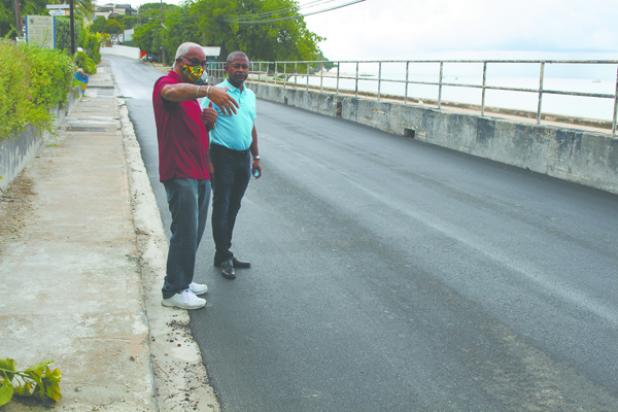
Deputy Chief Technical Officer, Philip Tudor (left) in conversation with Minister of Transport, Works and Water Resources, Ian Gooding-Edghill, while taking a close look at some of the work that was done in the Paynes Bay, St. James area.
Phase 1 of Highway project completed
Phase 1 of work in the reconstruction of Highway 1 has been completed.
This is according to Minister of Transport, Works and Water Resources, Ian Gooding-Edghill. However, he indicated that snagging, which “is the process of checking building works and compiling a list of unsatisfactory or outstanding works to be done”, is slated to be carried out shortly by the project manager.
He spoke to the media yesterday during a tour of sections of Highway 1. Work during the first phase – which covered 6,500 metres – was carried out from the Frank Walcott roundabout to Seaview Road. It commenced on November 2, 2020 and ended on August 11, 2021.
Gooding-Edghill stated that during the 37 weeks, approximately five weeks were lost due “to inclement weather; two weeks for the closure at Christmas into the New Year; two weeks for the National Pause; and two weeks as a result of the volcanic ash fall, a total of 11 weeks. The total productive time spent on this project was 26 weeks.”
He also disclosed that “more than 500 workers” were involved in project and it was completed without loss of life to anyone. He added that throughout the project there were only three infractions to the fibre optic network and that those cables that were damaged were quickly repaired by the telecommunications company, and service was restored in most instances in less than five hours.
“All mill and pave works have been completed and the highway now boasts two water mains, gas mains and provision for underground electricity on both sides of the road,” the minister stated.
Reflecting on the project, the Minister said what surprised the teams most “was the amount of hard rock on this highway considering its proximity to the sea. In section three for example, we also had challenges with springs and water flows across the road project.
“Another surprise was the extent of unknown locations of utilities in the areas. Despite the Ministry of Transport Works and Water Resources having utilised ground penetrating radar (GPR), we had to move rather gingerly to ensure we minimise disruption of utility services in the area.”
Looking ahead, Gooding-Edghill said for this phase of the project “evaluations have to be completed by the Quantity Surveyors section of the Ministry.”
“There are some outstanding areas for foot paths to be completed, soil to be laid above some footpaths, manhole covers to raise to bring them flush with the road surface, and a few inlets for drainage to be completed.
“They have identified some secondary roads that we will have to repave and we are reviewing the costs and the financing for such works.
“Also, they have to review the road network in the area to create more exit points for re-entry onto the highway and more road connectivity in the event of any emergencies. This has to be planned and wouldn’t be an overnight fix,” he added.
The budgeted cost for the project was $15.2 million. The Deputy Chief Technical Officer, Philip Tudor, who has responsibility for the project as project manager, has to advise Gooding-Edghill at a later date of the total cost of the project.
